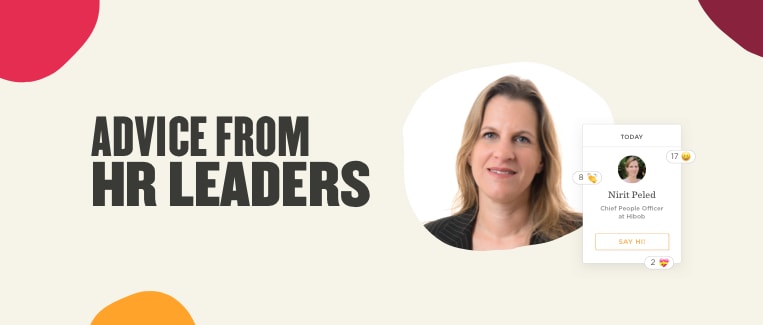When your team goes remote overnight, how do you rebuild communication practices and protocols to keep people productive, informed, and safe?
Nirit Peled Muntz, HiBob’s CPO, sat down with us to share a bit of the HiBob journey towards remote work and creating a sustainable hybrid remote work model. Read on for the secrets to keeping employees productive, aligned, and secure.
HiBob: What are you doing to keep your team engaged and motivated right now?
Nirit Peled Muntz: At HiBob currently all employees are working from home, so we have had to adjust our information flow. We’ve begun scheduling all-hands meetings where our CEO shares information with all our employees. Beyond that, communication practices depend on the team. Many teams have morning calls to make sure that all team members stay connected and know what is expected of them.
And, of course, we use Bob to provide information and motivation. We want to make sure that everybody is aware of successes, achievements, and milestones, in addition to all COVID-related governmental regulations and how we are addressing them.
HiBob: How do you track productivity and make sure employees stay productive during this period of time?
NPM: As always, we try to provide, first and foremost, a good environment for work. It’s a little like Maslow’s [Hierarchy], you need to start at the bottom and make sure all employees have a safe and healthy work environment that includes a chair and a desk. That’s not trivial! Some of our folks live in very small apartments that were not set up for a home office. They don’t always have space or equipment they need to work from home. So we sent the equipment they needed to make sure that they had at least a reasonable workspace. I believe that is basic.
In order to feel safe, employees need the flexibility to stay home when needed and keep themselves safe. In many places, the education systems were shut down, and people who have children to take care of were struggling. Other team members might be caring for older parents, or just juggling a heavy workload. We tried to be flexible with working hours and work location because some had to return to their parents’ homes or bring back their own children.
Having the whole company working remotely and from home actually created a sense of community and belonging because we now conducted video calls with everyone showing us a glimpse of their home and children or pets joining unintentionally. This actually brought us more together. The divide between the workplace and the homeplace was not there.
HiBob: What has helped your employees maintain a sense of stability in their work?
NPM: I think morale is strengthened when you provide employees with clearly-defined KPIs. When you have work to do and you know what is expected of you, it’s easy to create a path towards achieving your goals.
That’s definitely the case in uncertain times. It’s not just about making employees work hard, it’s about giving them a sense of direction and showing them how valuable their contribution is to company success. We are not 100% there, but we are doing our best to provide that kind of environment.
HiBob: Is HiBob considering the approach Mark Zuckerberg and Facebook have suggested of “remote when possible,” even after governments give the green light to return to work?
NPM: At HiBob we have decided that we want to keep things as flexible as possible. Even in Israel, where businesses can start returning to normal (with special regulations), the main consideration is safety. We need to try and test things carefully.
Some employees may feel unsafe to come to the office, and that’s a very personal choice. We decided that in Israel we will allow up to 25 employees each day to come to the office but they have to sign up to do so, take their temperature, and sign the health declaration required. We have enough space to maintain social distancing regulations and make sure they feel safe, only a handful of employees requested to work from the office, and I think that’s totally fine. It’s also fine if employees want to continue to work from home. Some teams actually chose one day a week to meet at the office. My directive is to allow the flexibility that supports safety and productivity at the same time.
HiBob: How has the cadence of management meetings changed, as a result of the new situation, to maintain productivity? Are you able to react quickly as a company to changing realities?
NPM: We [the management team] are meeting more frequently than before coronavirus times, sharing more with people managers, and making sure that managers and teams hold regular meetings in addition we use our Bob platform for company-wide communication posts and we conduct video conferencing all-hands meetings.
We need to get together virtually more often because we can’t rely on coffee and lunches and other interactions that we have in the office—but also because things are changing so fast. As managers, we need to be connected to employees and quick to address all issues and challenges.


